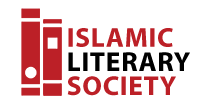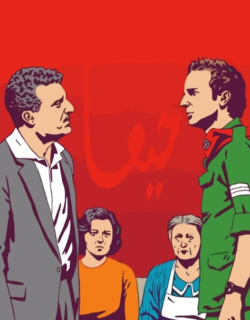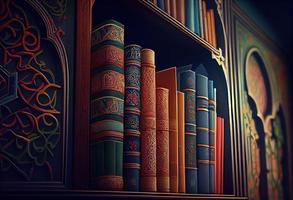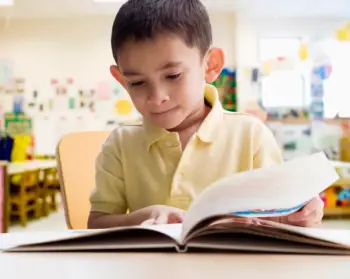Poster by David Polansky, courtesy of The Palestine Poster Project Archives.
By Adnan Mahmud
Hailed as the commanding voice of Palestinian resistance literature, Ghassan Kanafani dedicated his fiction to articulating the psychological as well as the material dispossession of his people. His seminal novella “Returning to Haifa” (عائد إلى حيفا) encapsulates this twofold mission – laying bare the intricate aftermath of settler-colonial occupation in dense contexts shaped by the idioms of homeland, history, and selfhood. This text reveals Kanafani’s unique literary gift: exposing the radiance of redemption’s resilient persistence even within the darkness of despair, or a hope within hopeless spaces.
Assassinated at 36 by a Mossad car bomb for his political commitments, Kanafani belonged to a generation of Palestinian writers actively engaged in anti-colonial struggle. Emerging soon after the seismic trauma of the 1948 Nakba which displaced over 700,000 natives, his work probes the enduring impacts of exile, loss, and statelessness on individual and communal consciousness.
Precisely because uncompromisingly political, Kanafani dialled into prose’s supreme capacity to engender empathy across ideological divides. This universalist impulse critiques without dehumanising, and skilfully elaborates symbolism and rich characterisation to excavate universal truths around identity and belonging from within milieus of extreme conflict.
Kanafani himself was a stateless person in Beirut after he had to flee Haifa as a boy. First published in 1969, “Returning to Haifa” is today considered one of the seminal statements of Palestinian anguish and aspiration. Inspired thus by a real expulsion, it chronicles a displaced couple’s fraught homecoming to their occupied city and subsequent encounter with the Jewish family now inhabiting their stolen home and parenting their very son. This heart-wrenching drama lays bare the intricate legacies and inheritances of loss across racial, generational, and geographic divides – thus, renewing dignity for the defeated even as colonialism’s crimes persist.
I argue that within “Returning to Haifa,” Kanafani artfully unearths reservoirs of empathy and mutual understanding – or lattices of intimacies – between enemies despite conditions of oppression, dispossession, and repossession. It is this insistence on uncovering shared dimensions of truth and humanity, and flickers of morality across the borderlines of occupier and occupied, that enduringly rages against the proclaimed erasure of the defeated.
Firmly modernist in literary sensibility, Kanafani’s prose discerns strata of emotional depth through spare yet lyrical detail. A crisp naturalism modulates resonant political symbolism. Meticulous physical descriptions mirror psychic landscapes, the material environment becoming a metaphor for psychological exile.
Kanafani reveals how the insistence of human intimacy, retained even across seemingly unbridgeable chasms of power abuse, can restore dignity and agency to those stripped of rights, voices, and homeland. Through intricately crafted characterisation elucidating the interior lives of both colonised and coloniser, he advances a moral vision that recognises the essential inseparability of foe from foe, for redemption rests on the promise of excavating universality from superimposed division. Similarly, he amplifies moral complexity both through articulating dichotomies – victim and oppressor, past and present, blood relation against chosen kinship, ascribed identity, and voluntary affiliation – and exploring nuanced patterns of entanglement across these seemingly opposed groups.
Even as it exposes the intricate traumas of exile, the text subtly yields glimmers of shared loss and humanity across racial, religious, and political lines, advancing Kanafani’s conviction that oppressed and oppressor are deeply interrelated through modes of victimisation. If freedom is indivisible, the oppressors, somewhat paradoxically, needs to be liberated from their blind spots as much as the oppressed need to be reclaimed from their material destitution.
Plot
This evocative novella, inspired firmly by Kanafani’s own childhood exile from Haifa during 1948, begins with Saeed and Safiya, a Palestinian couple tragically uprooted from their home in Haifa, upon the devastation of war. Their lives are fundamentally altered when their infant child, Khaldun, is inadvertently left behind during a frantic Israeli onslaught, an astute scenario that illustrates the profound disorientation and despair inflicted by conflict.
The story takes a profound turn when Khaldun, now named “Dov,” is adopted by an elderly Polish Jewish couple, themselves seeking refuge and solace in a land scarred by strife. This couple, having been allocated the abandoned residence of Saeed and Safiya, become somewhat unwitting participants in a narrative of loss and displacement. Khaldun, now Dov, grows up under their care, his identity moulded by beliefs and ideas foreign to his bio-cultural heritage.
Years later, in the aftermath of the 1967 war, an era defined by escalating Arab-Israeli tensions, Saeed and Safiya embark on a perilous journey back to Haifa, driven by an unwavering hope to reunite with their son. Their precarious journey testifies to the tenacity of the human spirit in the face of hardship. Upon reaching their former home, now inhabited by Miriam, they confront a past that has been irrevocably altered. Miriam’s narrative, interwoven with their own, reflects the shared experiences of displacement and longing amongst people on both sides of the conflict.
The anticipated reunion with Khaldun, however, unfolds with heartrending complexity. The encounter, far from resulting in the warm embrace envisaged, is marred by rejection and rift. Khaldun, now Dov, entrenched in his adopted identity, views his biological parents through a lens of resentment and disillusionment. This painful interaction lays bare the deep-seated ramifications of conflict on both personal identities and familial bonds.
Central to the narrative are the dialogues between Saeed and Dov, which are a poignant exploration of themes such as humanity, homeland, and identity. These exchanges are not merely personal; they echo the broader existential and moral dilemmas faced by individuals caught in the crossfires or crosshairs of geopolitical strife. Saeed’s transformation into a committed advocate for his homeland, and Dov’s ensuing identity crisis, reflect a nuanced contemplation of the complexities and the contradictions animating the quest for self-determination, belonging, and peace.
In this narrative, the plight of the Palestinian people, exemplified by the story of Saeed and Safiya, is portrayed with a profound sense of empathy and understanding. Their experiences symbolise the larger struggle for recognition and rights within a landscape marked by historical fault lines, inherited trauma, and ongoing conflict. The story serves as a contemplative reflection on the enduring quest for identity and belonging amidst the turbulent backdrop of the Israeli-Palestinian conflict.
Key Characters
Saeed
The central character, Saeed, emerges as a symbol of the Palestinian people’s displacement and their relentless quest for identity and homeland. Kanafani meticulously crafts Saeed’s narrative to delve into the profound psychologically unsettling and existential crisis faced by those uprooted by the incursion of foreign forces into their cities. Saeed’s journey is not just a physical displacement from his home and city, but a deeper odyssey into the heart of loss, identity, and the enduring trauma of leaving behind his child in the unfolding chaos. His initial denial and rationalisation of his departure, portrayed as involuntary and a sole recourse, are pivotal in understanding the complex psyche of a dispossessed individual.
Kanafani’s portrayal of Saeed initially appears direct and somewhat superficial, a strategic literary decision to underscore his innocence in the harrowing decision to flee his homeland. This narrative approach is intended not merely to retain Saeed’s stature as the protagonist but to illuminate the intricate layers of guilt, confusion, and moral ambiguity that define the Palestinian experience of displacement.
The narrative reaches an agonising climax when, twenty years later, Saeed returns to his erstwhile home. Here, Kanafani introduces a powerful counter-narrative through the character of Miriam, a Jewish old woman who now inhabits Saeed’s home and has adopted his son, Khaldun, renamed ‘Dov’. This encounter is not just a confrontation with the physical occupation of his space, but a profound psychological battle. Saeed’s and Safiya’s internal turmoil is meticulously depicted through their actions and expressions, manifesting as deep-seated anger and bitterness, emblematic of a people grappling with the erasure of their identity and history.
In the latter part of the novel, Saeed emerges as a figure imbued with wisdom and foresight, epitomising the collective sacrifices of the Palestinian people. His evolution from a passive, isolated figure to an impassioned advocate for his homeland encapsulates a dynamic and multifaceted character, resonating deeply with the universal struggle for self-determination and identity amidst the ravages of conflict and occupation. Kanafani, through Saeed, not only narrates a story of personal loss and transformation but also crafts a profound commentary on the enduring Palestinian quest for homeland and identity in the face of relentless upheaval.
Dov
Ghassan presents ‘Dov’ as a character embodying the complex intersections of identity, culture, and history. As the child inadvertently left behind during the occupation of Haifa, Dov becomes a living symbol and existential microcosm of the intricate and often painful realities of cultural and familial displacement. Raised as an Israeli Jew, Dov’s character challenges conventional understandings of race, blood, and lineage, representing a new generation that views these concepts through a lens shaped by personal experiences rather than inherited narratives.
Kanafani’s portrayal of Dov evolves from direct to indirect characterisation, a narrative strategy that subtly invites the reader to traverse the layers of his identity and, perhaps, to empathise with his stance, even as it opposes that of Saeed, the protagonist. This empathetic connection is particularly potent given Dov’s initial ignorance of his true heritage and his subsequent struggle to reconcile his adopted identity with the revelation of his Arab parentage.
Dov articulates his worldview in a manner that reflects both a social and an intellectual disposition shaped by his upbringing. His declaration that the revelation of his true parentage has not altered his sense of self speaks to a deeper philosophical question about the nature of identity: Is it defined by lineage and blood, or by the experiences and beliefs that shape one’s life?
However, Kanafani does not depict Dov as undergoing a significant transformation; he remains relatively stable in his convictions. This lack of change, juxtaposed with his internal conflict and growing doubt, particularly in response to Saeed’s arguments about homeland and identity, adds a further layer of complexity to his character. Nevertheless, Dov’s facade of confidence gradually erodes, revealing a deeper turmoil and a sense of being adrift between two worlds.
Miriam
Miriam emerges as an understated yet morally vital character, her peaceable composure anchoring chaotic upheaval. As a caregiver to her adopted Palestinian son, Dov, she forms an intimacy that defies ethnic allegiances, epitomising empathy’s ability to transcend binaries even amid violent conflict. This motherly affection for the ‘other’ inserts an ethical perspective into the frenzied climate of dehumanisation that occupation engenders.
While Miriam’s background remains vague, her name’s sacral resonances convey compassion – actualised in the dedicated mothering of Dov despite surrounding violence. Her affection for Dov heightens raging tensions amid the fraught reunion with his Palestinian family, against backdrops where torn loyalties underscore the intricate humanity of enemies, real or projected.
Rather than undergo any affective transformation, Miriam’s constancy spotlights her symbolic purpose – to retain dignity and nuanced reason against the ideological barrage. She recognises Dov’s right to self-identification despite the painful contradiction of his bio-cultural heritage. This subtle affirmation of his agency and autonomy makes Miriam a vital counterforce, and a vital embodiment of coexistence’s elusive possibility.
The dignity and compassion Miriam retains in nurturing Dov spotlight the hope within hopeless spaces – no matter how intractable the pervasive enmity, the possibility for reciprocity persists when the humanity of adversarial groups gets recognised, and thus steadily restored. Her steady moral compass amid the boundless trauma suggests glimmers of grace, keeping the dream of conscience alive when the nightmare of history threatens to swallow it. However contingent political settlements may be, the pilgrim of genuine intimacy may yet find her true home.
Khaled
Khaled’s brief yet pivotal presence explores intergenerational dynamics within Palestinian resistance. Barely an adult, his decision to join the militant struggle contrasts sharply with his father Saeed’s cautious defeatism that is borne of repetitive dispossession. This difference highlights evolving intergenerational change in confronting occupation, from weary resignation to fervent self-sacrifice.
His symbolic name evoking honour and optimism, Khaled represents the patriotic codification of youth who scarcely knew a pre-Nakba world. Too young to be tempered by past trauma, Khaled’s robust character channels the contemporary zeitgeist of armed uprising and steadfast loyalty to Palestine’s identity.
Safiya
While Safiya is not the central protagonist, her presence is vital – it is her obstinate maternal intimacy that catalyses the story’s pivotal journey back towards reunion. Despite the futility of return after years apart from her son, her longing to retrieve him from across enemy lines underscores the tenacity of love to spark hope even in the bleakest catastrophe of exile. This drive to reclaim the tissues of human bonds almost sundered by the acids of conflict speaks to the undergirding vigour of intimacy that propels Kanafani’s radical dissent against dispossession.
Even as the attempted reunion dissolves Safiya’s fervent yearning into disillusion, the consuming fire for reconciliation continues to indict separation as an affront to dignity. Through both her defiant hope and her resulting anguish, Safiya embodies the spirit of restoration at the crux of re-envisioning enemy affinity even amidst structural asymmetries. Hers is the resolute dance between expectancy and devastation that activism against erased histories must repeatedly enact, demanding universal intimacy by virtue of our shared vulnerability.
Significance and Impact
Through Khaldun/Dov’s convoluted hybrid identity, an existential site both of promise and of peril, of invitation and of threat, Kanafani underscores that human aspirations often transcend ethnic, social, or religious affiliations. By depicting a child who is adopted into Judaism after being born Palestinian yet struggles to work with or reconcile his two lineages, Kanafani reveals our shared fundamental yearning for purpose and belonging, regardless of externally imposed divisions. Dov’s inner turmoil represents the artificiality of categorisations that pit ‘Arab’ against ‘Jew’ even as individuals on both sides seek dignity, self-realisation, and security. His deft characterisation delegitimises narratives of an irreconcilable surd, subtly hinting at possibilities for compassionate common ground.
Miriam emerges as a vitally humanising character, her profound kindness and adoption of Dov directly rebutting Zionist tropes of inherent Arab animosity. By presenting her empathy amidst the surrounding violence, Kanafani defuses propagandistic radicalisation from the Israeli side, depicting coexistence as an ongoing possibility. When she shelters Dov, she acts without ethnic partiality, underscoring our human duty to promote welfare without regard to tribal lineages, and especially manufactured divides. Her character embodies and enacts the enduring message that people should be judged individually rather than by the communities they involuntarily inherit, thus challenging essentialist projections of hostility towards Arabs, arguably inherent to Zionism.
The heated dialogue between Saeed and Dov mirrors attempts by Palestinian rights activists to break through the miasma of wilful ignorance that often veils asymmetric warfare’s immorality.Saeed fruitlessly implores his son to wake up, but the son’s upbringing within the occupation’s complex has rendered him unable to appreciate the tragic limitations of a hopeless father trapped amid the turmoil of an equally brutal asymmetric occupation. This cyclical dynamic resembles ongoing campaigns to focus global attention on Gaza’s sweeping devastation. Reports of thousands being killed and millions suffocated by blockades are only met with rationalisations of bombing as self-defence, while structural dehumanisation continues to fuel intergenerational suffering. Yet like Saeed, some activists persist in forcing a rethinking through peaceable means. Kanafani expresses visceral truths around life under the unspeakable singularity of occupation, conveying a psychological realism generally ignored by diplomatic sophistries or governmental platitudes. Through this personified exchange of Saeed and Dov, the text vividly crystallises various obstacles that obscure the anguish of the Gazans, while underscoring a moral duty to recognise shared personhood across constructed battle lines.
Finally, amidst this tempest of tragedies and treacheries, there was this vase that Kanafani ingeniously used as though it were the silent narrator of the entire story. In fact, at the apex of his emotional turmoil, faced with the rejection of his fatherhood and the dehumanisation of his people by his very son, Saeed on multiple occasions counts the number of feathers in that vase. This shows us that the often mundane and overlooked observations of life hold the very key to ground ourselves—even at the peak of oppression—and fight for finding hope within hopeless spaces.



